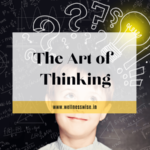
- by Dr. Alka Saxena
- | Views :2150
- Read :5 Minutes
Nowadays, we are so engrossed in our phones and other devices that we frequently fail to notice what other people are saying. Even though we may be able to hear what the other person is saying, are we genuinely paying attention? How many of you have had friends or relatives remark that you are not giving them your whole attention when they are speaking to you? This post is absolutely for you if you are one of these individuals.
Why do we communicate?

Communication is a base for our social life. It is essential for human beings to communicate to foster cooperation and is a critical life skill for survival. If we look around us, we will realize that humans are constantly communicating with each other. We are keen to share our thoughts and ideas with others. We like to tell our family members and friends about our experiences and how our day was at school, home or work place. We communicate to inform others about our feelings and desires.
Good communication is essential for an organization’s effectiveness. Poor communication can give rise to interpersonal conflicts and may lead to strain in our relationships.
Types of Communication

In ancient times various means were used for communication. For instance, the cave paintings were a way of visual communication and depicted important events. Other forms included oral storytelling, pigeon carriers, drums and horns and smoke signals.
Essentially, communication can be verbal, nonverbal, visual or written.
Verbal communication remains one of our leading means of conveying messages. It includes speeches, formal or informal one-to one discussions, group discussions and telephone calls. The main advantage of verbal communication is that the message is immediately conveyed and feedback can be taken instantly. However, those of us who have played the Telephone or Chinese whisper game will understand that the verbal message is likely to get distorted especially if it has to be passed from one person to another.
Written communication can be in the form of letters, e-mails, memos, notices or written messages. It is documented, concrete, verifiable and can be referred to when required. Additionally, written matter is likely to be well thought through and clear. However, it is more time-consuming and liable to misinterpretation at times.
Visual communication includes photographs, signs and symbols, maps, mind maps, charts, diagrams and presentations. They transcend language barriers and are easy to understand and remember. They are especially helpful for visual learners.
In addition to verbal messages, we are always giving nonverbal cues which are adding meaning to our conversations. Our facial expressions can display our emotions and interest in the dialogs. Tapping feet or fingers may be interpreted as impatience and a shrug of the shoulders as indifference. A smile could indicate encouragement and interest in a conversation.
Effective Communication

Communication is a two-way process between the sender and the receiver. The primary objective of effective communication is to convey information such that the recipient understands it as precisely as possible to the intended meaning.
To communicate effectively, we need to focus on both the components. In verbal communication, the speaker is the sender and the listener is the receiver.
As a speaker, it is important to choose our words thoughtfully to convey our message as precisely as we can. We often come across people trying to impress us with their technical jargon. I usually lose interest in such conversations. While technical words may be required in our official exchanges, they sound almost like a foreign language to a lay person. Hence, I prefer to keep the language simple as it aids in fostering better connection with others. In addition, we need to be mindful of our tone and pitch. The pauses in our sentences are as important to convey the meaning effectively. The use of commas at different places could entirely change the meaning of a sentence. For instance, consider the sentence- “The panda eats shoots and leaves.” It conveys a very different meaning when the position of commas is changed to- “The panda eats, shoots, and leaves.”
The role of the listener is equally significant. It is important to learn the art of active listening. A listener needs to be non-judgemental and their facial expressions and body language should show attentiveness.
Active listening implies listening with our whole body and letting the other person know our intent. It means listening to the other person with complete focus, without distractions. It also suggests that we engage with the speaker by giving verbal affirmations and nonverbal cues like nodding, and making comfortable eye contact. Another aspect of active listening is showing genuine interest to understand the other’s perspective. As Stephen R. Covey (author of The 7 Habits of Highly Effective People) says, “Most people do not listen with the intent to understand; they listen with the intent to reply.”
Often people are seeking an empathetic ear and not really expecting us to suggest solutions to them. As a parent, it took me a little while to comprehend that my kids would at times complain only because they were tired and were not looking for any real time change.
Asking the speaker for clarification, paraphrasing and summarizing are ways to confirm that we have understood them correctly. This in turn, helps the speaker feel heard and aids to strengthen our interpersonal bonds.
What are some of the ways you adopt to strengthen your communication skills. Share in the comments below.
“Sometimes all a person wants is an empathetic ear; all he or she needs is to talk it out. Just offering a listening ear and an understanding heart for his or her suffering can be a big comfort.”― Roy T. Bennett


This presentation is nice
I hope they really improve my conversation skills
Glad you found it helpful! Consistent practice makes a big difference.
I like it because l learn about many things
Curiosity is the best way to grow
Good
I like it because l learn about many things